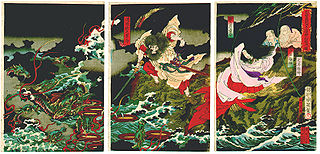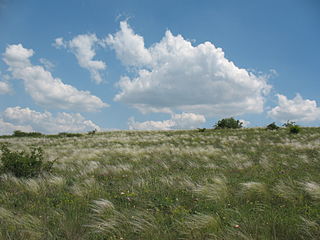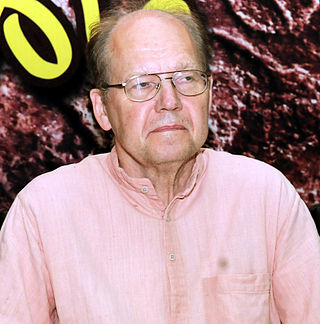
Leonard Bloomfield was an American linguist who led the development of structural linguistics in the United States during the 1930s and the 1940s. He is considered to be the father of American distributionalism. His influential textbook Language, published in 1933, presented a comprehensive description of American structural linguistics. He made significant contributions to Indo-European historical linguistics, the description of Austronesian languages, and description of languages of the Algonquian family.

Yamata no Orochi, or simply Orochi (大蛇), is a legendary eight-headed and eight-tailed Japanese dragon/serpent.

Hittite, also known as Nesite, is an extinct Indo-European language that was spoken by the Hittites, a people of Bronze Age Anatolia who created an empire centred on Hattusa, as well as parts of the northern Levant and Upper Mesopotamia. The language, now long extinct, is attested in cuneiform, in records dating from the 17th to the 13th centuries BC, with isolated Hittite loanwords and numerous personal names appearing in an Old Assyrian context from as early as the 20th century BC, making it the earliest attested use of the Indo-European languages.

Proto-Indo-European mythology is the body of myths and deities associated with the Proto-Indo-Europeans, speakers of the hypothesized Proto-Indo-European language. Although the mythological motifs are not directly attested – since Proto-Indo-European speakers lived in preliterate societies – scholars of comparative mythology have reconstructed details from inherited similarities found among Indo-European languages, based on the assumption that parts of the Proto-Indo-Europeans' original belief systems survived in the daughter traditions.

Kuchean was a Western member of Tocharian branch of Indo-European languages, extinct from ninth century. Once spoken in the Tarim Basin in Central Asia. Tocharian B shows an internal chronological development; three linguistic stages have been detected. The oldest stage is attested only in Kucha. There are also the middle ('classicalʼ), and the late stage.

*Dyḗus, also *Dyḗus ph₂tḗr, is the reconstructed name of the daylight-sky god in Proto-Indo-European mythology. *Dyēus was conceived as a divine personification of the bright sky of the day and the seat of the gods, the *deywṓs. Associated with the vast diurnal sky and with the fertile rains, *Dyēus was often paired with *Dʰéǵʰōm, the Earth Mother, in a relationship of union and contrast.

Graeco-Aryan, or Graeco-Armeno-Aryan, is a hypothetical clade within the Indo-European family that would be the ancestor of Hellenic, Armenian, and the Indo-Iranian languages, which spans Southern Europe, Armenian highlands and Southern Asian regions of Eurasia.
George Luzerne Hart, III is Professor Emeritus of Tamil language at the University of California, Berkeley. His work focuses on the classical Tamil literature and on identifying the relationships between the Tamil and Sanskrit literature. In 2015 the Government of India awarded him the title of Padma Shri, the fourth highest civilian honour.

Asko Parpola is a Finnish Indologist, current professor emeritus of South Asian studies at the University of Helsinki. He specializes in Sindhology, specifically the study of the Indus script.

South Picene is an extinct Italic language belonging to the Sabellic subfamily. It is apparently unrelated to the North Picene language, which is not understood and therefore unclassified. South Picene texts were at first relatively inscrutable even though some words were clearly Indo-European. The discovery in 1983 that two of the apparently redundant punctuation marks were in reality simplified letters led to an incremental improvement in their understanding and a first translation in 1985. Difficulties remain. It may represent a third branch of Sabellic, along with Oscan and Umbrian, or the whole Sabellic linguistic area may be best regarded as a linguistic continuum. The paucity of evidence from most of the 'minor dialects' contributes to these difficulties.
George Cardona is an American linguist, Indologist, Sanskritist, and scholar of Pāṇini. Described as "a luminary" in Indo-European, Indo-Aryan, and Pāṇinian linguistics since the early sixties, Cardona has been recognized as the leading Western scholar of the Indian grammatical tradition (vyākaraṇa) and of the great Indian grammarian Pāṇini. He is currently Professor Emeritus of Linguistics and South Asian Studies at the University of Pennsylvania. Cardona was credited by Mohammad Hamid Ansari, the vice president of India, for making the University of Pennsylvania a "center of Sanskrit learning in North America", along with Professors W. Norman Brown, Ludo Rocher, Ernest Bender, Wilhelm Halbfass, and several other Sanskritists.

Proto-Armenian is the earlier, unattested stage of the Armenian language which has been reconstructed by linguists. As Armenian is the only known language of its branch of the Indo-European languages, the comparative method cannot be used to reconstruct its earlier stages. Instead, a combination of internal and external reconstruction, by reconstructions of Proto-Indo-European and other branches, has allowed linguists to piece together the earlier history of Armenian.
Edgar Howard Sturtevant was an American linguist.

A dragonslayer is a person or being that slays dragons. Dragonslayers and the creatures they hunt have been popular in traditional stories from around the world: they are a type of story classified as type 300 in the Aarne–Thompson classification system. They continue to be popular in modern books, films, video games and other forms of entertainment. Dragonslayer-themed stories are also sometimes seen as having a chaoskampf theme - in which a heroic figure struggles against a monster that epitomises chaos.

Bellerophon or Bellerophontes or Hipponous, was a divine Corinthian hero of Greek mythology, the son of Poseidon and Eurynome, and the foster son of Glaukos. He was "the greatest hero and slayer of monsters, alongside Cadmus and Perseus, before the days of Heracles", among his greatest feats was killing the Chimera of the Iliad, a monster that Homer depicted with a lion's head, a goat's body, and a serpent's tail: "her breath came out in terrible blasts of burning flame."
The grammar of the Hittite language has a highly conservative verbal system and rich nominal declension. The language is attested in cuneiform, and is the earliest attested Indo-European language.

Tarḫunna or Tarḫuna/i was the Hittite weather god. He was also referred to as the "Weather god of Heaven" or the "Lord of the Land of Hatti".

Calvert Watkins was an American linguist and philologist, known for his book How to Kill a Dragon. He was a professor of linguistics and the classics at Harvard University and after retirement went to serve as professor-in-residence at UCLA.
*Trito is a significant figure in Proto-Indo-European mythology, representing the first warrior and acting as a culture hero. He is connected to other prominent characters, such as Manu and Yemo, and is recognized as the protagonist of the myth of the warrior function, establishing the model for all later men of arms. In the legend, Trito is offered cattle as a divine gift by celestial gods, which is later stolen by a three-headed serpent named *H₂n̥gʷʰis ('serpent'). Despite initial defeat, Trito, fortified by an intoxicating drink and aided by the Sky-Father, or alternatively the Storm-God or *H₂nḗr, 'Man', together they go to a cave or a mountain, and the hero overcomes the monster and returns the recovered cattle to a priest for it to be properly sacrificed. He is now the first warrior, maintaining through his heroic deeds the cycle of mutual giving between gods and mortals. Scholars have interpreted the story of Trito either as a cosmic conflict between the heavenly hero and the earthly serpent or as an Indo-European victory over non-Indo-European people, with the monster symbolizing the aboriginal thief or usurper. Trito's character served as a model for later cattle raiding epic myths and was seen as providing moral justification for cattle raiding. The legend of Trito is generally accepted among scholars and is recognized as an essential part of Proto-Indo-European mythology, although not to the level of Manu and Yemo.
*H₂n̥gʷʰis is a reconstructed Proto-Indo-European term meaning 'serpent', as well as a possible name for a mythological entity, polycephalous sea serpent or dragon which was slain by a hero named Trito with a help of god Perkʷunos.













